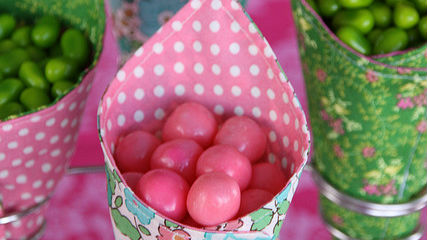What a “Wedding Merchants” Convention Taught Me about Marriage

I’ve always suspected, to paraphrase an adage from evolutionary science, that the marriage replicates the wedding. The wedding’s style is a germinal expression of the marriage to come, its strengths, vulnerabilities, and dreams.
Looking back, many of my marriage’s resources and weaknesses were reflected in the design of my wedding and how we went about planning it. Although naturally I didn’t notice that at the time, worried as I was about votive candles and cake.
To learn more I attended an annual gathering of wedding merchants in Arizona, when I was working on my book about marriage. This was at the start of the recession in 2008. The dire economics for wedding vendors (people who sell any kind of wedding service, from music to flowers) in a fiercely competitive, $40 billion a year business seemed to haunt the “Academy,” as they named it. Several speakers and participants gravitated toward lethal metaphors of hunting and being hunted. They talked about nimbly stalking potential bride-customers in what insiders call the “engagement zone” (“being 27 and in love puts you in The Zone,” explained one speaker); finding ways to “capture the bride that YOU want;” and gleaning that inscrutable and “elusive species”: the modern, wired bride.
One of the speakers at the conference was Jennifer Fallon, the founder and CEO of Kate Aspen Favors. Fallon started her professional life selling medical software to physicians. She shifted over to wedding favors and other “life events” products after she got engaged in 2001. “I’m not a package kind of girl,” she explained, and “I couldn’t find anything unique,” the “perfect venue” for her wedding.
When she finally found that exceptional venue, she financed its use by agreeing to market it for the owner to other brides for a year, and she managed to book every single weekend. Fallon roved from there to “unique and different” wedding favors. They were all “blah and predictable,” so she sensed opportunity. After all, over 100,000 brides were typing in “wedding favors” on Google in a single month, searching restlessly for something no one had seen before.
So Fallon designed a topiary place-card holder for wedding reception tables and set up a Yahoo store in January 2004, at first taking orders only by fax. The business skyrocketed.
She built it from nothing to $1.2 million in one year, because she understood the core paradox of weddings today: Fallon mass-marketed items to create a unique, personalized and singular wedding.
It’s a dramatic shift in weddings from fifty years ago, this quest for individuality. No more the conformity of my parents’ generation, which married in obedience to orthodoxy and script. They gave out tulle-wrapped Jordan almonds as favors, and wore white veils. Weddings proudlydisplayed conformity, a bride and groom’s willingness to get submerged in a social role.The wedding ceremony required only (not that it was a small task) the bride’s mastery of seating arrangement and napkin-folding etiquette. She didn’t have to invent or write a wedding script. She just had to perform one successfully.
There wasn’t a wedding contingency that the Vogue etiquette guide hadn’t covered for her. It’s a formidably—or, seen another way, a reassuringly—thick volume.
Vogue advised that if a “girl hopes that a beau will become a fiancé,” she must “refuse and return as tactfully as possible” any major gifts and, “definitely, any underclothes” offered by him as gifts. Meanwhile the fiancé can bring “wine or small delicacies” if invited to his fiancee’s apartment, and “within reason, replenish her liquor supply, as a gesture of appreciation.” At the ceremony, if the bride is wearing gloves, “the seams of the ring finger should be slit so she need not take off the entire glove” to receive her wedding ring. It’s all spelled out for you.
Today, in contrast, a wedding is treated almost as a unique branding moment for our lives.
Often in my conversations I’d hear the phrase the “wedding industry,” or the wedding-industrial complex, by engaged couples understandably beleaguered by the cannonade of manipulative, pre-nuptial consumerism. But it’s not strictly speaking an industry at all. An industry mass produces the same homogeneous mass product according to the same assembly-line, homogeneously mechanical processes.
Weddings today aspire to the opposite. They display our customized views and taste. The more unique and reflective of the spouses’ personalities they are, the better. A successful wedding consultant at the conference reported from the frontlines that brides are “jumping out of the box. They want to make the wedding their own, they want to make it different.” Myself, I’ve been to everything from pig roasts, luaus, formal Catholic masses, and football-themed weddings.
At the Academy, a wedding consultant elaborated that she thought of herself as a “wedding author.” She writes the bride’s story in the living performance art of a reception. Another merchant commented that brides today are “personalized” (although it’s hard to imagine that they were ever anything but personalized, to themselves at least). They conceive of themselves as in the “service business, not the product business.” As vendors see it, they aren’t selling things. They’re “selling emotion. We’re selling how the guest feels when they walk in, how the guest feels when they get a key chain” as a favor. More boldly, a wedding planner in the audience proposed, “you must find out where the bride is emotionally and where she wants to end up emotionally.” Because ultimately, it’s about “making the bride feel comfortable with herself… She’s buying herself” in the wedding, she pondered aloud.
It’s an odd business, to sell a bride her dream identity of herself to herself. But this did seem to be their mission.
I left the “Academy” feeling as if weddings are as eclectically improvised as ideas of marriage are becoming. The marriage replicates the wedding. For my parents the challenge was that they had almost no meaningful lifestyle choices. Most all were going to get married and, within marriage, the majority would follow the established gender roles, and achieve the same benchmarks. Today we have choices galore. One wedding consultant tried to group all these personalized brides into categories of “modern,” “vintage,” or “edgy” (and another added the “eco-bride” to the roster). It struck me that the main “types” of wifehood in the U.S. today could loosely be described in similar terms.
Every marriage era has its trade-offs, its upsides and downsides. Still, if I had to pick, I’d go for the unique over the ambivalent consolations of conformity in the tulle-wrapped Jordan almond favor-giving day of yore. It makes for a more self-realized marriage (and wedding). But it’s not always easy, or better than what came before.





